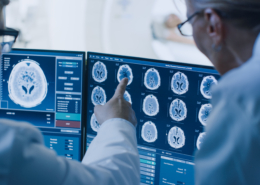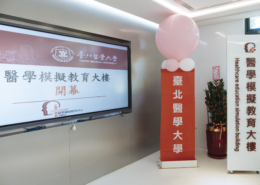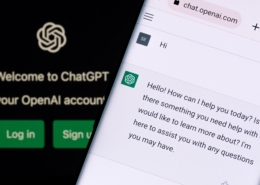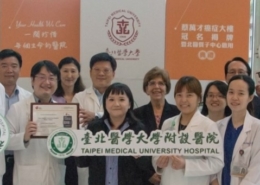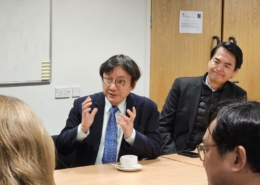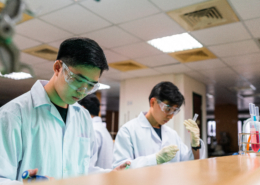Wearable devices are the new tech frontier:
UK-based platform attracts 4000 students to TMU course
on ways to help elders while cutting health costs
Recently Dr. Shabbir Syed-Abdul returned for an encore visit with TMU’s journalism students. A month earlier he explained the Internet of Things [IoT] hackathon (see related story), but in November he detailed a much larger enterprise.
His second online course on FutureLearn attracted more than 4000 students for a four-week course on IoT applications to support preventive and other health care for elders. Near the end of that course, he shared his insights in this group interview.
Q: In your course introduction, we could see what students would learn about elders’ health problem-solving and development of tools for this. But what is the core value you think learners can get from this course?
A: Why did we start this course? First of all, we want to see what the age-related real problems are. There are thousands of problems, but we must focus on the most common and expensive problems which we will have in the future.
The first issue is related with falls. You may think this is a simple thing, but it is a big problem in elderly populations. If you fall once, then you have a higher likelihood of falling again. We want to prevent falls.
The second major issue is stroke rehabilitation. We want to provide tools/devices for patients that enable them to do rehabilitation at home — so we would be able to know how much exercise patients are doing.
The third issue is dementia. We will have different strategies for different genders, and show how technology can keep these patients active.
These are the core values of this course. We also focus on problems and provide solutions using available wearable devices.
Q: How can we promote the idea of these wearable devices for elders? And how do we choose reliable and professional experts to create reliable and clear instructions?
A: We need assistance from the doctor’s side and the government side. For example, the government sets up the policy promoting patients monitoring their blood pressure at home — then the doctor can receive the data by clicking one button.
Q: Currently, scientists are trying to invent robots to help doctors do things such as diagnosis, medical care, or maybe surgery. However, people are worried about if an accident happened during surgery conducted by a robot, who should be responsible? It’s impossible for us to accuse a robot. If these wearable devices or other IoT applications perform incorrectly, who should be responsible? Is it the designer, the manufacturer, or doctors?
A: Any device before using goes through scrutinizing methodology to check its accuracy, perhaps by the FDA. Devices record your heart rate, and even if they show some error, they are not going to do any harm.
You talk about another very serious thing like robots doing surgery. Obviously, for anything that was being treated by doctors, it is not like patients are going to a robot, saying their complaint, and robots do the surgery. That’s not going to happen. Patients go to doctors, and then doctors decide whether they should use robots or not.
Even if you use the robots, why you think we are using them?
We use robots because of accuracy. Because we are human beings, our hands may shake (minor vibrations) when we do surgery, and usually in brain or in heart surgery, it may be sensitive and dangerous. Even if you touch one millimeter apart, you may damage arteries or veins.
We use robots to overcome these vibrations of our hands. To approach the pathology concretely, we have more advantages using robots. Then, obviously, who should be responsible? The ones using the robot will be responsible — obviously not the robot.
Q: People living in rural areas may find it more difficult to receive these new technologies. How do we distribute them far and wide, so these people can enjoy their benefits?
A: Nowadays people have mobile phones, so it is easy to receive medical related information such as reminders for follow-ups and re-filling of the medication via SMS. If someone goes to the hospital and gets this technology, they can take advantages of such new technologies.
Q: I have heard news reports saying the pharmaceutical industry is unwilling to provide drugs to relatively poor countries because they couldn’t earn profits there. So I am wondering whether these countries have equal opportunities to take advantage of high-tech health care.
A: That’s another political concern. Because usually when we talk about developing countries, poor countries, they have more people, like millions or billions. Then when you talk about developed countries, there are few people. For example, Norway only has 5 million population, and Switzerland also only has 6 to 7 million. Even if you take Taiwan, it has only 20 to 25 million. If you talk about big countries like China, India, Africa, there are like, hundreds of millions. So if we have mass production, the government will support these innovations to lower health care costs.
But we should see what they really need. Do they need technology, or do they need drinking water or toilets? So needs are different for each country. You cannot think only technology can help solve all problems. If you use India’s solutions in Taiwan, that doesn’t work, or vice versa.
So we should go to each country, and learn what problems need to be solved. For some problems, technology may not be useful. For example, drinking water: you cannot give me a device and say that it will provide drinking water. That’s definitely not the answer for this problem.
Q: Since you mentioned that Taiwan’s health system still keeps health spending relatively low by global standards, how we can make a balance between a lower cost and a better Taiwan health system by promoting the Internet of Things? Are there any feasible projects now?
A: This is a good question. How can new technologies actually save money, instead of adding costs? I think this is your question.
The fact is that the elderly need more care. They are the population who visit the hospital a lot. You go to any hospital, you will see more elderly people.
So what we want to do is monitor elderly patients at home. We want to reduce their complication rates. We don’t want to wait for a patient to get ill, and then come to hospital and be treated. Once a patient gets ill and comes to hospital and doctors starts treatments, costs are higher. This is what we have been doing for many years, but that’s not going to happen in Taiwan.
Because now we want to focus on prevention. We want to use technology for prevention. For example, by using the wearable devices, the doctor knows how much the patient has walked. The treatment will be not just based on what the patient has said. That is the reason why we want the technology being promoted in our health system. Obviously, if they visit the hospital less, the cost will be lower.
Q: Since Taiwan’s health care system faces financial constraints, do you have any solutions for this?
A: The United States spends 17% of GDP on health and still a lot of people are uncovers and lot of them are unsatisfied; Taiwan spends only 6 or 7% of GDP, covers 99% of population and most people are satisfied. So you can’t say it is not good financially. But this is why we want to use technology to help patients at home. If they don’t need to come to the hospital, this is how we use technology to save money.
For interviews or a copy of the paper, contact Office of Global Engagement via global.initiatives@tmu.edu.tw.

